
United Kingdom Infrared Telescope
Encyclopedia
UKIRT, the United Kingdom Infra-Red Telescope
, is a 3.8 metre (150 inch) infrared
reflecting telescope, the largest dedicated infrared (1 to 30 micrometres) telescope in the world. It is operated by the Joint Astronomy Centre
in Hilo and located on Mauna Kea
, Hawai'i
as part of Mauna Kea Observatory
. It is owned by the United Kingdom Science and Technology Facilities Council
.
Based on the design of the Carlos Sanchez Telescope in Tenerife
it is a Cassegrain device with a thin primary mirror, around 2/3 thinner than in other contemporary devices and weighing only 6.5 tonnes. The mirror is held in a massive steel 'cell' of 20 tonnes which is linked to the supports by Serrurier truss
es. The instrument is held and pointed by a massive 'English Equatorial mounting' or yoke which sits on ball-bearings on steel piers, swinging east-west and rotating around north-south. The geometry of the mount limits the telescopes access to objects between +60 and -40 degrees of declination but it is extremely sturdy and free from deformation and so allows very accurate pointing. The telescope was built between 1975 and 1978; the mechanical systems were built by Dunford Hadfields of Sheffield and the optics by Grubb Parsons of Newcastle. Originally known as the Infrared Flux Collector it began operation in October 1979.
A UKIRT infrared survey was used to discover a redshift distance record breaking Quasar
in 2011. The Quasar could not be seen in visible light, but could in the longer wavelengths observed by UKIRT.
ranging from 0.8 arcseconds at dusk to 0.5 arcseconds in the early morning http://www.jach.hawaii.edu/UKIRT/publications/Newsletter/issue10/UKnews.html. Between 1998 and 2003, two major software projects were undertaken - the ORAC project providing a major upgrade to the user interface and automating telescope operations, and the OMP providing a comprehensive observation database and data feedback mechanisms. Since 2003, using these two software enhancements, UKIRT has carried out highly efficient flexible scheduling - tailoring observation execution to the prevailing weather conditions. Observations are selected from the database according to the current seeing, atmospheric water vapour, sky transparency and a science priority allocated by the telescope time allocation panel.
, UKIDSS). This project takes some 80% of the available telescope time in wide-field mode. Wide-field takes some 60% of the telescope; the other 40% is devoted to operations with the Cassegrain instrumentation. In December 2008 it was announced that the telescope would be moving to wide-field mode full time http://www.jach.hawaii.edu/UKIRT/news/WF_Announcement.html.
It was announced on 16 December 2009 that the telescope is "subject to discussions leading to managed withdrawal"
http://www.scitech.ac.uk/News+and+Events/13710.aspx.
Here is the UKIRT (then called Infrared Flux Collector) compared to the other largest optical telescopes circa 1978, only a some of these could also see in the near infrared.
Other large optical infrared near infrared telescopes in 1980
Two other large but smaller near IR telescopes were WIRO 2.3 in Wyoming, USA, the Gornergrat Infrared Telescope
(TIRGO, 1.5 m) in the Swiss alps, and a 1.6 m at Mont Mégantic Observatory in Canada.
Telescope
A telescope is an instrument that aids in the observation of remote objects by collecting electromagnetic radiation . The first known practical telescopes were invented in the Netherlands at the beginning of the 1600s , using glass lenses...
, is a 3.8 metre (150 inch) infrared
Infrared
Infrared light is electromagnetic radiation with a wavelength longer than that of visible light, measured from the nominal edge of visible red light at 0.74 micrometres , and extending conventionally to 300 µm...
reflecting telescope, the largest dedicated infrared (1 to 30 micrometres) telescope in the world. It is operated by the Joint Astronomy Centre
Joint Astronomy Centre
The Joint Astronomy Centre operates British, Canadian and Dutch telescopes at Mauna Kea Observatory, and provides support for other telescopes and public outreach activities...
in Hilo and located on Mauna Kea
Mauna Kea
Mauna Kea is a volcano on the island of Hawaii. Standing above sea level, its peak is the highest point in the state of Hawaii. However, much of the mountain is under water; when measured from its oceanic base, Mauna Kea is over tall—significantly taller than Mount Everest...
, Hawai'i
Hawaii
Hawaii is the newest of the 50 U.S. states , and is the only U.S. state made up entirely of islands. It is the northernmost island group in Polynesia, occupying most of an archipelago in the central Pacific Ocean, southwest of the continental United States, southeast of Japan, and northeast of...
as part of Mauna Kea Observatory
Mauna Kea Observatory
The Observatories at Mauna Kea, , are an independent collection of astronomical research facilities located on the summit of Mauna Kea on the Big Island of Hawai'i, USA. The facilities are located in a special land use zone known as the "Astronomy Precinct," which is located in the Mauna Kea...
. It is owned by the United Kingdom Science and Technology Facilities Council
Science and Technology Facilities Council
The Science and Technology Facilities Council is a UK government body that carries out civil research in science and engineering, and funds UK research in areas including particle physics, nuclear physics, space science and astronomy .-History:It was formed in April 2007 as a merger of the Particle...
.
Based on the design of the Carlos Sanchez Telescope in Tenerife
Tenerife
Tenerife is the largest and most populous island of the seven Canary Islands, it is also the most populated island of Spain, with a land area of 2,034.38 km² and 906,854 inhabitants, 43% of the total population of the Canary Islands. About five million tourists visit Tenerife each year, the...
it is a Cassegrain device with a thin primary mirror, around 2/3 thinner than in other contemporary devices and weighing only 6.5 tonnes. The mirror is held in a massive steel 'cell' of 20 tonnes which is linked to the supports by Serrurier truss
Serrurier truss
A Serrurier truss is used in telescope tube assembly construction. The design was created in 1935 by engineer Mark U. Serrurier when he was working on the Mt. Palomar Hale telescope. The design solves the problem of truss flexing by supporting the primary objective mirror and the secondary mirror...
es. The instrument is held and pointed by a massive 'English Equatorial mounting' or yoke which sits on ball-bearings on steel piers, swinging east-west and rotating around north-south. The geometry of the mount limits the telescopes access to objects between +60 and -40 degrees of declination but it is extremely sturdy and free from deformation and so allows very accurate pointing. The telescope was built between 1975 and 1978; the mechanical systems were built by Dunford Hadfields of Sheffield and the optics by Grubb Parsons of Newcastle. Originally known as the Infrared Flux Collector it began operation in October 1979.
A UKIRT infrared survey was used to discover a redshift distance record breaking Quasar
Quasar
A quasi-stellar radio source is a very energetic and distant active galactic nucleus. Quasars are extremely luminous and were first identified as being high redshift sources of electromagnetic energy, including radio waves and visible light, that were point-like, similar to stars, rather than...
in 2011. The Quasar could not be seen in visible light, but could in the longer wavelengths observed by UKIRT.
Instrumentation
UKIRT has three Cassegrain instruments and a wide-field imager placed forward of the Cassegrain focus.- CGS4 is a cooled-grating spectrometer with a 90-arcsecond long slit, at spectral resolutionSpectral resolutionThe spectral resolution of a spectrograph, or, more generally, of a frequency spectrum, is a measure of its ability to resolve features in the electromagnetic spectrum...
s between about 1,000 and 30,000. - UFTI is a 1024x1024 pixel imager operating between 0.8 and 2.5 micrometreMicrometreA micrometer , is by definition 1×10-6 of a meter .In plain English, it means one-millionth of a meter . Its unit symbol in the International System of Units is μm...
s. - UIST is a 1024x1024 pixel imager/spectrometer operating between 0.8 and 5 micrometres, and offering an integral field mode 3x6 arcseconds in size.
- WFCAM (at forward Cassegrain) is a wide-field imager with four 2048x2048 arrays, each of which covers a field 13.6 arcminutes on a side, for a total field of view of about 0.2 square degrees.
Upgrades
Built as a relatively cheap telescope, UKIRT has been extensively upgraded. A program of improvements from 1990 to 1998 greatly improved the imaging performance, and in 2001 the telescope delivered median infrared seeingAstronomical seeing
Astronomical seeing refers to the blurring and twinkling of astronomical objects such as stars caused by turbulent mixing in the Earth's atmosphere varying the optical refractive index...
ranging from 0.8 arcseconds at dusk to 0.5 arcseconds in the early morning http://www.jach.hawaii.edu/UKIRT/publications/Newsletter/issue10/UKnews.html. Between 1998 and 2003, two major software projects were undertaken - the ORAC project providing a major upgrade to the user interface and automating telescope operations, and the OMP providing a comprehensive observation database and data feedback mechanisms. Since 2003, using these two software enhancements, UKIRT has carried out highly efficient flexible scheduling - tailoring observation execution to the prevailing weather conditions. Observations are selected from the database according to the current seeing, atmospheric water vapour, sky transparency and a science priority allocated by the telescope time allocation panel.
Current operations
With the delivery of the wide-field imager WFCAM in 2004, UKIRT began a revolutionary large-scale sky survey (the UKIRT Infrared Deep Sky SurveyUKIRT Infrared Deep Sky Survey
The UKIRT Infrared Deep Sky Survey or UKIDSS is an astronomical survey conducted using the WFCAM wide field camera on the United Kingdom Infrared Telescope on Mauna Kea in Hawaii...
, UKIDSS). This project takes some 80% of the available telescope time in wide-field mode. Wide-field takes some 60% of the telescope; the other 40% is devoted to operations with the Cassegrain instrumentation. In December 2008 it was announced that the telescope would be moving to wide-field mode full time http://www.jach.hawaii.edu/UKIRT/news/WF_Announcement.html.
It was announced on 16 December 2009 that the telescope is "subject to discussions leading to managed withdrawal"
http://www.scitech.ac.uk/News+and+Events/13710.aspx.
Contemporaries on commissioning
Although seeing in the infrared, the UKIRT was large for an optical telescopes and signaled a coming focus on this part of the spectrum that only grew in the coming decades.Here is the UKIRT (then called Infrared Flux Collector) compared to the other largest optical telescopes circa 1978, only a some of these could also see in the near infrared.
| # | Name(s) / Observatory |
Image | Aperture | Spectrum | Altitude | First Light |
Special advocate |
|---|---|---|---|---|---|---|---|
| 1 | BTA-6 Special Astrophysical Obs |
238 inch 605 cm |
Visible | 2070 m (6791 ft) |
1975 | Mstislav Keldysh Mstislav Keldysh Mstislav Vsevolodovich Keldysh was a Soviet scientist in the field of mathematics and mechanics, academician of the USSR Academy of Sciences , President of the USSR Academy of Sciences , three times Hero of Socialist Labor , fellow of the Royal Society of Edinburgh . He was one of the key figures... |
|
| 2 | Hale Telescope Hale telescope The Hale Telescope is a , 3.3 reflecting telescope at the Palomar Observatory in California, named after astronomer George Ellery Hale. With funding from the Rockefeller Foundation, he orchestrated the planning, design, and construction of the observatory, but did not live to see its commissioning... Palomar Obs. Palomar Observatory Palomar Observatory is a privately owned observatory located in San Diego County, California, southeast of Pasadena's Mount Wilson Observatory, in the Palomar Mountain Range. At approximately elevation, it is owned and operated by the California Institute of Technology... |
 |
200 inch 508 cm |
Visible | 1713 m (5620 ft) |
1949 | George Ellery Hale George Ellery Hale George Ellery Hale was an American solar astronomer.-Biography:Hale was born in Chicago, Illinois. He was educated at MIT, at the Observatory of Harvard College, , and at Berlin . As an undergraduate at MIT, he is known for inventing the spectroheliograph, with which he made his discovery of... |
| 3 | Mayall Telescope Nicholas U. Mayall Telescope The Nicholas U. Mayall Telescope is a four meter reflector telescope located at the Kitt Peak National Observatory and named after Nicholas U. Mayall. It saw first light on February 27, 1973. Initial observers included: D. Crawford, Nicholas Mayall, and Arthur Hoag. It was dedicated on June 20,... Kitt Peak National Obs. Kitt Peak National Observatory The Kitt Peak National Observatory is a United States astronomical observatory located on 2,096 m Kitt Peak of the Quinlan Mountains in the Arizona-Sonoran Desert on the Tohono O'odham Nation, southwest of Tucson... |
158 inch 401 cm |
Visible | 2120 m (6955 ft) |
1973 | Nicholas Mayall Nicholas Mayall Nicholas Ulrich Mayall was an American observational astronomer. After obtaining his doctorate from the University of California, Berkeley, Mayall worked at the Lick Observatory, where he remained from 1934–1960, except for a brief period at MIT's Radiation Laboratory during World War II.During... |
|
| 4 | Blanco Telescope Victor M. Blanco Telescope The Víctor M. Blanco Telescope, also known as the Blanco 4m, is a 4m telescope located at the Cerro Tololo Inter-American Observatory, Chile. Commissioned in 1974 and completed in 1976, this telescope is similar to the Mayall 4m telescope located on Kitt Peak. In 1995 it was dedicated and named in... CTIO Obs. Cerro Tololo Inter-American Observatory The Cerro Tololo Inter-American Observatory is a complex of astronomical telescopes and instruments located at 30.169 S, 70.804 W, approximately 80 km to the East of La Serena, Chile at an altitude of 2200 metres. The complex is part of the National Optical Astronomy Observatory along with Kitt... |
158 inch 401 cm |
Visible | 2200 m 7217 feet |
1976 | Nicholas Mayall Nicholas Mayall Nicholas Ulrich Mayall was an American observational astronomer. After obtaining his doctorate from the University of California, Berkeley, Mayall worked at the Lick Observatory, where he remained from 1934–1960, except for a brief period at MIT's Radiation Laboratory during World War II.During... |
|
| 5 | Anglo-Australian Telescope Anglo-Australian Telescope The Anglo-Australian Telescope is a 3.9 m equatorially mounted telescope operated by the Australian Astronomical Observatory and situated at the Siding Spring Observatory, Australia at an altitude of a little over 1100 m... Siding Spring Obs. Siding Spring Observatory Siding Spring Observatory near Coonabarabran, New South Wales, Australia, part of the Research School of Astronomy & Astrophysics at the Australian National University , incorporates the Anglo-Australian Telescope along with a collection of other telescopes owned by the Australian National... |
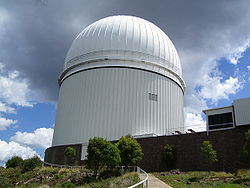 |
153 inch 389 cm |
Visible | 1742 m (5715 ft) |
1974 | Prince Charles Charles, Prince of Wales Prince Charles, Prince of Wales is the heir apparent and eldest son of Queen Elizabeth II and Prince Philip, Duke of Edinburgh. Since 1958 his major title has been His Royal Highness The Prince of Wales. In Scotland he is additionally known as The Duke of Rothesay... |
| 6 | United Kingdom Infrared Telescope Joint Astronomy Centre Joint Astronomy Centre The Joint Astronomy Centre operates British, Canadian and Dutch telescopes at Mauna Kea Observatory, and provides support for other telescopes and public outreach activities... |
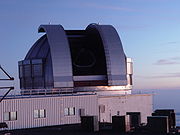 |
150 inch 380 cm |
Infrared | 4205m (13,800 ft) |
1979 | |
| 7 | ESO 3.6 m Telescope ESO European Southern Observatory The European Southern Observatory is an intergovernmental research organisation for astronomy, supported by fifteen countries... La Silla Obs. La Silla Observatory La Silla Observatory is an astronomical observatory in Chile with three telescopes built and operated by the European Southern Observatory organisation, and several others are partly maintained by ESO... |
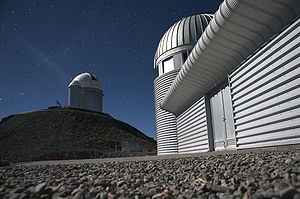 |
140 inch 357 cm |
Visible Infrared | 2400 m m (7874 ft) |
1977 | Adriaan Blaauw |
| 8 | Shane Telescope C. Donald Shane telescope The C. Donald Shane telescope is a reflecting telescope located at the Lick Observatory in California. It was named after astronomer C. Donald Shane in 1978, who led the effort to acquire the necessary funds from the California Legislature, and who then oversaw the telescope's construction... Lick Observatory Lick Observatory The Lick Observatory is an astronomical observatory, owned and operated by the University of California. It is situated on the summit of Mount Hamilton, in the Diablo Range just east of San Jose, California, USA... |
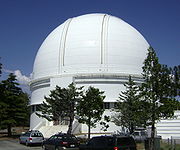 |
120 inch 305 cm |
Visible | 1283 m (4209 ft) |
1959 | Nicholas Mayall Nicholas Mayall Nicholas Ulrich Mayall was an American observational astronomer. After obtaining his doctorate from the University of California, Berkeley, Mayall worked at the Lick Observatory, where he remained from 1934–1960, except for a brief period at MIT's Radiation Laboratory during World War II.During... |
Comparison to other early infrared telescopes
Dedicated near infrared telescopes require a high and dry location, special instrumentation, and similar high quality mirrors and optics as for visible wavelength observations.Other large optical infrared near infrared telescopes in 1980
| # | Name(s) / Observatory |
Image | Aperture | Spectrum | Altitude | First Light |
|---|---|---|---|---|---|---|
| 1 | United Kingdom Infrared Telescope Joint Astronomy Centre Joint Astronomy Centre The Joint Astronomy Centre operates British, Canadian and Dutch telescopes at Mauna Kea Observatory, and provides support for other telescopes and public outreach activities... |
 |
150 inch 380 cm |
Infrared | 4205m (13,800 ft) |
1979 |
| 2 | ESO 3.6 m Telescope ESO European Southern Observatory The European Southern Observatory is an intergovernmental research organisation for astronomy, supported by fifteen countries... La Silla Obs. La Silla Observatory La Silla Observatory is an astronomical observatory in Chile with three telescopes built and operated by the European Southern Observatory organisation, and several others are partly maintained by ESO... |
 |
140 inch 357 cm |
Visible Infrared | 2400 m m (7874 ft) |
1977 |
| 3 | NASA Infrared Telescope Facility Mauna Kea Observatory Mauna Kea Observatory The Observatories at Mauna Kea, , are an independent collection of astronomical research facilities located on the summit of Mauna Kea on the Big Island of Hawai'i, USA. The facilities are located in a special land use zone known as the "Astronomy Precinct," which is located in the Mauna Kea... |
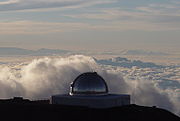 |
118 inch 300 cm |
Infrared | 4205m (13,800 ft) |
1979 |
Two other large but smaller near IR telescopes were WIRO 2.3 in Wyoming, USA, the Gornergrat Infrared Telescope
Gornergrat Infrared Telescope
The Telescopio InfraRosso del Gornergrat is located on the northern tower of the Kulm Hotel at Gornergrat near Zermatt, Switzerland. It was a Cassegrain telescope with a tip-tilt correcting secondary and optimized for infrared observations, but was decommissioned in March 2005...
(TIRGO, 1.5 m) in the Swiss alps, and a 1.6 m at Mont Mégantic Observatory in Canada.
External links
- http://www.jach.hawaii.edu/UKIRT
- http://www.jach.hawaii.edu/UKIRT/telescope/telescope.html
- http://www.ukidss.org/

